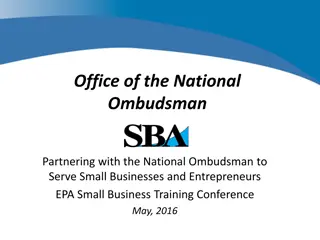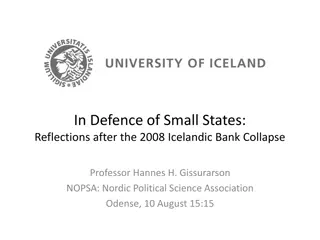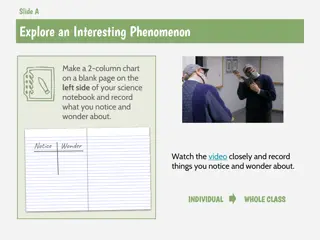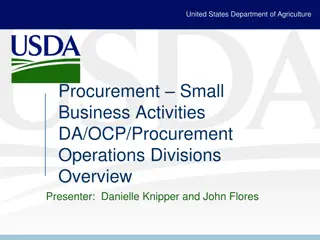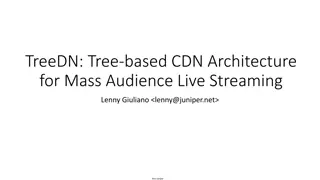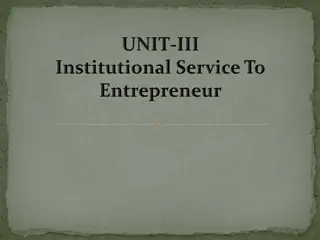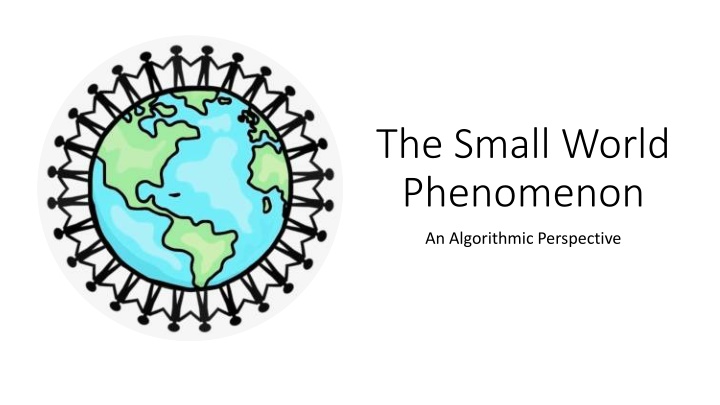
The Small World Phenomenon: A Detailed Analysis
Explore the concept of the small world phenomenon from an algorithmic perspective, discussing the six degrees of separation and the efficiency of constructing short routes between individuals. Discover insights from Milgram's experiment and the construction of graphs to delve into the intriguing world of human connections and network structures.
Download Presentation

Please find below an Image/Link to download the presentation.
The content on the website is provided AS IS for your information and personal use only. It may not be sold, licensed, or shared on other websites without obtaining consent from the author. If you encounter any issues during the download, it is possible that the publisher has removed the file from their server.
You are allowed to download the files provided on this website for personal or commercial use, subject to the condition that they are used lawfully. All files are the property of their respective owners.
The content on the website is provided AS IS for your information and personal use only. It may not be sold, licensed, or shared on other websites without obtaining consent from the author.
E N D
Presentation Transcript
The Small World Phenomenon An Algorithmic Perspective
The six degrees of separation The two degrees of separation in Z rich Anecdotal evidence? Introduction
Are we separated by only 6 links to any other person in the world? Two Questions to answer: Could we efficiently construct such a short route to any other person?
Milgrams Experiment Deliver a letter to a random other person => only within USA Average count of steps was around 6 It seems These shorts paths do not only exist, but they are efficiently constructable by humans. Could we efficiently construct such a short route to any other person?
Milgrams Experiment Extracting Milgrams results ? log(300 ???????)2 6 ? 12 Degrees of separation in the world: degrees of separation in Z rich: 1 1 12 log(7 ???????)2 8 1 12 log(400 000)2 2.5 Are we separated by only 6 links to any other person in the world?
Construction of Graph Why a graph? Mix of Close and Long range contacts seems optimal
Construction of Graph p = 1 diameter of the local circle q = 1 count of long-range contacts n = 6 width/height of the lattice
Problem at hand message holder h target t Message delivered to t as fast as possible h can only send to its own contacts
The two (three) things h knows the set of local contacts among all nodes (i.e. the underlying grid structure); the location, on the lattice, of the target t; and the locations and long-range contacts of all nodes that have come in contact with the message.
Probability distribution of long range contacts ?(?,?) is the distance between u and v on the lattice Introduction of parameter r The larger r, the closer the long range contacts If r = 0, long range contacts are uniformly randomly distributed ?(?,?) ? ??(?,?) ? P[ Long range contact of u is v ] =
Three Theorems of this Paper ? = 0 => slow r = 2 and p = q = 1 => fast 0 ? < 2 ?? 2 < ? => slow
Upper Bound for r = 2 Principle of deferred decisions p = q = 1 Probability that v is long range contact of u: ?(?,?) 2 ??(?,?) 2
Proof Ingredient 1. (Ripple Pattern) 2? 2 ?(?,?) 2 4? ? 2 ? ? ?=1 4 ln(6?) Pr[ u chooses v ] [4ln 6? ?(?,?)2] 1
Lets slice our problem into phases Our algorithm is in phase j if the lattice distance from the current message holder to the target is between 2j and 2j+1 Phase n - 2 Phase n -1 Phase n Bj= set of nodes within distance 2jof t
Bj= set of nodes within distance 2jof t Proof Ingredient 2. 2? ? = > 22? 1nodes in Bj There are atleast 1 + ?=1 Max distance between cn and fn: 2?+1+ 2?< 2?+2 The message enters Bj with probability at least 22? 1 ?(?,?) 2 ??(?,?) 2 22? 1 1 = 4 ln 6? (2?+2)2= 128 ln(6?)
Putting it all together Let Xj = total number of steps in phase j Through geometric distribution with p 1 128 ln(6?) ? ?? =1 Let X = total number of steps in our algorithm Max log(n) phases because 2log(n) = nlog(2) = n ? = ?=0 ? 128ln(6?) log(?)?? 1 + log ? (128ln(6?)) ? log(?)2
Lower Bound for 0 r < 2 p, q => any value Use the ripple effect to estimate
? = some constant depending on r ? = some constant depending on p, q and r Some definitions Let U = Set of nodes within lattice distance ???of t Let event = within ??? steps we reach a node other than t that has a long range contact in U Pr 1 4 Let event = Lattice distance between s and t => greater than n/4 Pr 1 2 Let event = within ???steps we are at t Let ?= number of steps needed to reach t
Let event = within ???steps we reach a node other than t that has a long range contact in U Let event = Lattice distance between s and t => greater than n/4 Let event = within ???steps we are at t Let ?= number of steps needed to reach t (i) Pr | = 0, hence Pr ? | ??? (ii) Pr 1 2 3 4 1 4 => ? ? Pr ? | Pr 1 4???
Conclusion The graph modeled in our analysis seems to be pervasive in many aspects of our life. The following networks have been shown to exhibit such a structure: World Wide Web Social Networks Neurons

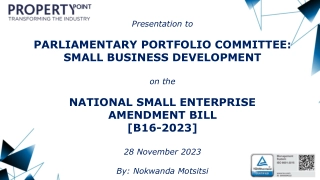






![The Exciting World of Live Music Through [Insert Town/City] Census!](/thumb/148894/the-exciting-world-of-live-music-through-insert-town-city-census.jpg)



